This is an old revision of this page, as edited by Hiplibrarianship (talk | contribs) at 04:18, 22 April 2024 (→Origins: better). The present address (URL) is a permanent link to this revision, which may differ significantly from the current revision.
Revision as of 04:18, 22 April 2024 by Hiplibrarianship (talk | contribs) (→Origins: better)(diff) ← Previous revision | Latest revision (diff) | Newer revision → (diff) Annual cycle of seasonal festivals observed by modern pagans "Sabbat" redirects here. For other uses of Sabbat, see Sabbat (disambiguation). For Wheel of time, see Wheel of time (disambiguation). For the song by GFriend, see Walpurgis Night (album).
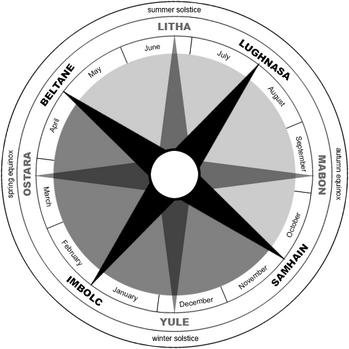
The Wheel of the Year is an annual cycle of seasonal festivals, observed by a range of modern pagans, marking the year's chief solar events (solstices and equinoxes) and the midpoints between them. British neopagans crafted the Wheel of the Year in the mid-20th century, combining the four solar events ("quarter days") marked by many European peoples, with the four seasonal festivals ("cross-quarter days") celebrated by Insular Celtic peoples. Different paths of modern Paganism may vary regarding the precise timing of each celebration, based on such distinctions as the lunar phase and geographic hemisphere.
Observing the cycle of the seasons has been important to many people, both ancient and modern. Modern pagan festivals that rely on the Wheel are based to varying degrees on folk traditions, regardless of actual historical pagan practices. Some Wiccans use the term sabbat (/ˈsæbət/) to refer to each festival.
Origins
Seasonal festival activities of pagan peoples differed across ancient Europe. Among the British Isles, Anglo-Saxons primarily marked the solar stations (solstices and equinoxes), while Insular Celtic peoples marked the four midpoints between them. The four Celtic festivals were known to the Gaels as Beltane (1 May), Lughnasadh (1 August), Samhain (1 November), and Imbolc (1 February).
Influential works such as The Golden Bough (1890) by James George Frazer explored various European seasonal festivals and their possible pagan roots. The Witch-Cult in Western Europe (1921) by Margaret Murray examined reports of the European witch trials, including a 1661 trial record from Forfar, Scotland, where the accused witch (Issobell Smyth) was alleged to attend witches meetings "every quarter" at Candlemas (2 February), Roodmas (3 May), Lammas (1 August), and Hallowmas (1 November). The White Goddess (1948) by Robert Graves suggested that, despite Christianization, the importance of agricultural and social cycles had preserved eight holidays of "the ancient British festal system", consisting of Candlemas (2 February), Lady Day (25 March), May Day (1 May), Midsummer Day (24 June), Lammas (1 August), Michaelmas (29 September), Halloween (31 October), and Christmas (25 December).

Two neopagan groups in Britain popularized these seasonal festival calendars in the twentieth century: the Bricket Wood coven, a Wiccan group led by Gerald Gardner, and the Order of Bards, Ovates and Druids, a neo-Druidic group led by Ross Nichols. Legend holds that Gardner and Nichols harmonized an eight-fold calendar during a naturist retreat, merging the four solar stations alongside their four midpoints as a unified festival cycle. Coordination eventually had the benefit of better aligning celebrations between the two neopagan groups. Gardner's first publications refer to the Celtic festivals as "May eve, August eve, November eve (Hallowe'en), and February eve".
The phrase 'Wheel of the Year' was in use by the mid-1960s to describe an annual cycle of eight observances. Prominent Wiccan Aidan Kelly gave names to the Wiccan summer solstice (Litha) and equinox holidays (Ostara and Mabon) in 1974, which were then promoted by Timothy Zell through his Green Egg magazine. Popularization of these names happened gradually; in her 1978 book Witchcraft For Tomorrow, influential Wiccan author Doreen Valiente did not use Kelly's holiday names, instead simply identifying the solstices and equinoxes ("Lesser Sabbats") by their seasons. Valiente identified the four "Greater Sabbats", or fire festivals, by the names Candlemas, May Eve, Lammas, and Hallowe'en, while also naming their Gaelic counterparts Imbolc, Beltane, Lughnasa, and Samhain.
Due to early Wicca's influence on modern paganism and the syncretic adoption of Anglo-Saxon and Celtic motifs, Wheel of the Year festival names in English commonly combine the Celtic names used by Gardner and the Germanic-derived names introduced by Kelly, regardless whether local celebrations are based on those cultures.
Festivals

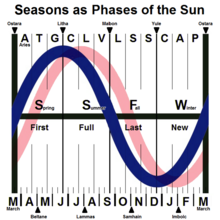
In many traditions of modern pagan cosmology, all things are considered to be cyclical, with time as a perpetual cycle of growth and retreat tied to the Sun's annual death and rebirth. This cycle is also viewed as a micro- and macrocosm of other life cycles in an immeasurable series of cycles composing the Universe. The days that fall on the landmarks of the yearly cycle traditionally mark the beginnings and middles of the four seasons. They are regarded with significance and host to major communal festivals. These eight festivals are the most common times for community celebrations.
In addition to the quarter and cross-quarter days, other festivals may also be celebrated throughout the year, especially in the context of polytheistic reconstructionism and other ethnic traditions. While festivals of the Wheel are steeped in solar mythology and symbolism, many Wiccan esbats are commonly based on lunar cycles. Together, they represent the most common celebrations in Wiccan-influenced forms of modern paganism, especially in Neopagan witchcraft groups.
Winter Solstice (Midwinter / Yule)
Main articles: Winter solstice and Yule See also: Midwinter, Brumalia, and SaturnaliaMidwinter, which is marked around 21 December, has been recognized as a significant turning point in the yearly cycle since the late Stone Age. The ancient megalithic sites of Newgrange and Stonehenge, carefully aligned with the winter solstice sunrise and sunset, exemplify this. Although this position in the Wheel of the Year is sometimes referred to by the term "Yule", after the Germanic and later Northern European winter festival of the same name, Yule was not likely celebrated by Germanic heathens at the winter solstice before the Christianisation of the Germanic peoples. Consistent with historical sources, scholar Andreas Nordberg proposes that it occurred instead at the full moon of the lunisolar month following the winter solstice which could range between the 5th of January to the 2nd of February in the Gregorian calendar.
The reversal of the Sun's ebbing presence in the sky symbolizes the rebirth of the solar god and presages the return of fertile seasons. From Germanic to Roman tradition, this is the most important time of celebration.
Practices vary, but sacrifice offerings, feasting, and gift giving are common elements of Midwinter festivities. Bringing sprigs and wreaths of evergreenery (such as holly, ivy, mistletoe, yew, and pine) into the home and tree decorating are also common during this time.
In Roman traditions additional festivities take place during the six days leading up to Midwinter.
A name for the festival in neo-druidry is Alban Arthan,
Imbolc (Candlemas)
Main articles: Imbolc and Candlemas See also: DísablótImbolc is the traditional Gaelic name for 1 February and traditionally marks the first stirrings of spring. It aligns with the contemporary observance of Groundhog Day. It is time for purification and spring cleaning in anticipation of the year's new life. In Rome, it was historically a shepherd's holiday, while the Gaels associated it with the onset of ewes' lactation, prior to birthing the spring lambs.
For Celtic neopagans, the festival is dedicated to the goddess Brigid, daughter of The Dagda and one of the Tuatha Dé Danann.
In the Reclaiming tradition, this is the traditional time for pledges and rededications for the coming year and for initiation among Dianic Wiccans.
Spring Equinox (Ostara)
Main article: March equinox See also: Liberalia, Hilaria, and NowruzOstara is a name for the spring equinox in some modern pagan traditions. The term is derived from a reconstruction produced by linguist Jacob Grimm of an Old High German form of the Old English Ēostre, a proposed Anglo-Saxon goddess for whom, according to Bede, feasts were held in her eponymous month, which he equated to April in the Julian calendar.
Known as Alban Eilir in strands of neo-druidry, this holiday is the second of three spring celebrations (the midpoint between Imbolc and Beltane), during which light and darkness are again in balance, with light on the rise. It is a time of new beginnings and of life emerging further from the grips of winter.
Beltane (May Eve)
Main article: Beltane See also: May Day, Floralia, and Walpurgis NightBeltane or May Day, 1 May, is traditionally the first day of summer in Ireland. In Rome the earliest celebrations appeared in pre-Christian times with the festival of Flora, the Roman goddess of flowers, and the Walpurgisnacht celebrations of the Germanic countries.
Since the Christianisation of Europe, a more secular version of the festival has continued in Europe and America, commonly referred to as May Day. In this form, it is well known for maypole dancing and the crowning of the Queen of the May.
Celebrated by many pagan traditions, in neo-druidry this festival recognizes the power of life in its fullness, the greening of the world, youthfulness and flourishing.
Summer Solstice (Midsummer / Litha)
Main articles: Midsummer and Summer solsticeMidsummer, which is marked around 21 June, is one of the four solar holidays and is considered the turning point at which summer reaches its height. Some Wiccan traditions call the festival Litha, a name occurring in Bede's The Reckoning of Time (De Temporum Ratione, eighth century), which preserves a list of the (then-obsolete) Anglo-Saxon names for the months of the early Germanic calendar. Ærra Liða (first or preceding Liða) roughly corresponds to June in the Gregorian calendar, and Æfterra Liða (following Liða) to July. Bede writes that "Litha means gentle or navigable, because in both these months the calm breezes are gentle and they were wont to sail upon the smooth sea".
In some neo-druid traditions the festival is called Alban Hefin. The sun in its greatest strength is greeted and celebrated on this holiday. While it is the time of greatest strength of the solar current, it also marks a turning point, for the sun also begins its time of decline as the wheel of the year turns. Arguably the most important neo-druidic festival, due to the focus on the sun and its light as a symbol of divine inspiration. Neo-druid groups frequently celebrate this event at Stonehenge.
Lughnasadh (Lammas)
Main articles: Lughnasadh and LammasLughnasadh (/ˈluːnæsə/) is the Gaelic name for a harvest festival held on or around 1 August, while Lammas is an English name. Wiccans mark the holiday by baking a figure of the god in bread and eating it, to symbolize the sanctity and importance of the harvest. Celebrations vary, as not all Pagans are Wiccans. The Irish name Lughnasadh is used in some traditions to designate this holiday. Wiccan celebrations of this holiday are neither generally based on Celtic culture nor centered on the Celtic deity Lugh. This name seems to have been a late adoption among Wiccans. In early versions of Wiccan literature the festival is referred to as August Eve.
The name Lammas (contraction of loaf mass) implies it is an agrarian-based festival and feast of thanksgiving for grain and bread, which symbolises the first fruits of the harvest.
Autumn Equinox (Mabon)
Main article: September equinoxThe holiday of the autumnal equinox is known variously among neopagans as Harvest Home, Mabon, the Feast of the Ingathering, Meán Fómhair, An Clabhsúr, or Alban Elfed (in neo-druidry). It is a neopagan festival of thanksgiving for the fruits of the earth and a recognition of the need to share them to secure the blessings of the Goddess and the Gods during the coming winter months. The name Mabon was coined by Aidan Kelly around 1970 as a reference to Mabon ap Modron, a character from Welsh mythology.
Samhain (All Hallows)
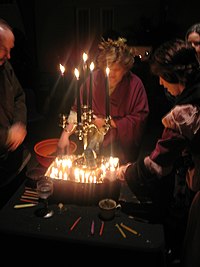
Samhain (/ˈsɑːwɪn/) is the name of a traditional Gaelic festival held around 1 November. The name and date were adopted by Wiccans for one of their four Greater Sabbats. For Wiccans, Samhain is a time to celebrate the lives of those who have passed on, and it often involves paying respect to ancestors, family members, elders of the faith, friends, pets, and other loved ones who have died. Aligned with the contemporary observance of Halloween and Day of the Dead, in some traditions the spirits of the departed are invited to attend the festivities. It is seen as a festival of darkness, which is balanced at the opposite point of the Wheel by the festival of Beltane, which is celebrated as a festival of light and fertility. Many neopagans believe that the veil between this world and the afterlife is at its thinnest point of the year at Samhain, making it easier to communicate with those who have departed.
Some authorities claim the Christian festival of All Hallows Day (All Saints Day) and the preceding evening are appropriations of Samhain by early Christian missionaries to the British Isles.
Practice
Celebration commonly takes place outdoors in the form of a communal gathering.
Dates of celebration
The precise dates on which festivals are celebrated often vary to some degree, as would the related agricultural milestones of the local region. Celebrations may occur on the astrologically precise quarter and cross-quarter days, the nearest full moon, the nearest new moon, or the nearest weekend for contemporary convenience. The festivals were originally celebrated by peoples in the middle latitudes of the Northern Hemisphere. Consequently, the traditional timing for seasonal celebrations do not align with the seasons in the Southern Hemisphere or near the equator. Pagans in the Southern Hemisphere often advance these dates by six months to coincide with their own seasons.
Offerings
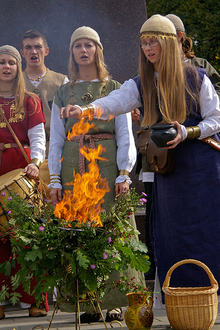
Offerings of food, drink, various objects, etc. have been central in ritual propitiation and veneration for millennia. Modern pagan practice strongly avoids sacrificing animals in favour of grains, herbs, milk, wines, incense, baked goods, minerals, etc. The exception being with ritual feasts including meat, where the inedible parts of the animal are often burned as offerings while the community eats the rest.
Sacrifices are typically offered to gods and ancestors by burning them. Burying and leaving offerings in the open are also common in certain circumstances. The purpose of offering is to benefit the venerated, show gratitude, and give something back, strengthening the bonds between humans and divine and between members of a community.
Heathen observances
Main article: Heathen holidays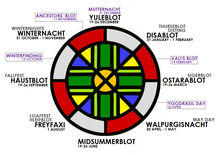
Heathens may add to the demarcations of the Wheel of the Year with various Days of Remembrance celebrating heroes of the Edda and the Sagas and figures of Germanic history such as Leif Ericson, who explored parts of North America. Heathen organisations using the Wheel of the Year framework for their festival calendar include the Swedish group Samfundet Forn Sed Sverige, the American inclusive group The Troth, and the folkish Ásatrú Alliance.
Narratives
Celtic
See also: Celtic mythologyIt is a misconception in some quarters of the modern pagan community, influenced by the writings of Robert Graves, that historical Celts had an overarching narrative for the entire cycle of the year. While the various Celtic calendars include some cyclical patterns, and a belief in the balance of light and dark, these beliefs vary between the different Celtic cultures. Modern preservationists and revivalists usually observe the four 'fire festivals' of the Gaelic Calendar, and some also observe local festivals that are held on dates of significance in the different Celtic nations.
Slavic

Slavic mythology tells of a persisting conflict involving Perun, god of thunder and lightning, and Veles, the black god and horned god of the underworld. Enmity between the two is initiated by Veles' annual ascent up the world tree in the form of a huge serpent and his ultimate theft of Perun's divine cattle from the heavenly domain. Perun retaliates to this challenge of the divine order by pursuing Veles, attacking with his lightning bolts from the sky. Veles taunts Perun and flees, transforming himself into various animals and hiding behind trees, houses, even people. (Lightning bolts striking down trees or homes were explained as results of this.) In the end Perun overcomes and defeats Veles, returning him to his place in the realm of the dead. Thus the order of the world is maintained.
The idea that storms and thunder are actually divine battle is pivotal to the changing of the seasons. Dry periods are identified as chaotic results of Veles' thievery. This duality and conflict represents an opposition of the natural principles of earth, water, substance, and chaos (Veles) and of heaven, fire, spirit, order (Perun), not a clash of good and evil. The cosmic battle between the two also echoes the ancient Indo-European narrative of a fight between the sky-borne storm god and chthonic dragon.
On the great night (New Year), two children of Perun are born, Jarilo, god of fertility and vegetation and son of the Moon, and Morana, goddess of nature and death and daughter of the Sun. On the same night, the infant Jarilo is snatched and taken to the underworld, where Veles raises him as his own. At the time of the spring equinox, Jarilo returns across the sea from the world of the dead, bringing with him fertility and spring from the evergreen underworld into the realm of the living. He meets his sister Morana and courts her. With the beginning of summer, the two are married bringing fertility and abundance to Earth, ensuring a bountiful harvest. The union of Perun's kin and Veles' stepson brings peace between two great gods, staving off storms which could damage the harvest. After the harvest, however, Jarilo is unfaithful to his wife and she vengefully slays him, returning him to the underworld and renewing enmity between Perun and Veles. Without her husband, god of fertility and vegetation, Morana – and all of nature with her – withers and freezes in the ensuing winter. She grows into the old and dangerous goddess of darkness and frost, eventually dying by the year's end only to be reborn again with her brother in the new year.
Wicca and Druidry
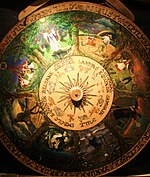
In Wicca, the narrative of the Wheel of the Year traditionally centers on the sacred marriage of the God and the Goddess and the god/goddess duality. In this cycle, the God is perpetually born from the Goddess at Yule, grows in power at the vernal equinox (as does the Goddess, now in her maiden aspect), courts and impregnates the Goddess at Beltane, reaches his peak at the summer solstice, wanes in power at Lammas, passes into the underworld at Samhain (taking with him the fertility of the Goddess/Earth, who is now in her crone aspect) until he is once again born from Her mother/crone aspect at Yule. The Goddess, in turn, ages and rejuvenates endlessly with the seasons, being courted by and giving birth to the Horned God.
Many Wiccan, modern Druids, and eclectic modern pagans incorporate a narrative of the Holly King and Oak King as rulers of the waning year and the waxing year respectively. These two figures battle endlessly with the turning of the seasons. At the summer solstice, the Holly King defeats the Oak King and commences his reign. After the Autumn equinox the Oak King slowly begins to regain his power as the sun begins to wane. Come the winter solstice the Oak King in turn vanquishes the Holly King.After the spring equinox the sun begins to wax again and the Holly King slowly regains his strength until he once again defeats the Oak King at the summer solstice. The two are ultimately seen as essential parts of a whole, light and dark aspects of the male God, and would not exist without each other.
The Holly King is often portrayed as a woodsy figure, similar to the modern Santa Claus, dressed in red with sprigs of holly in his hair and the Oak King as a fertility god.
See also
- Ember days, quarterly periods (usually three days) of prayer and fasting in the liturgical calendar of Western Christian churches.
- List of neo-pagan festivals and events
- Medicine wheel, metaphor for a variety of Native American spiritual concepts
- Solar terms, year's divisions in China and East Asia
Calendars
References
- Williams, Liz (29 July 2013). "Paganism, part 3: the Wheel of the Year". The Guardian. Retrieved 23 October 2021.
- ^ Harvey, Graham (1994). "The Roots of Pagan Ecology". Journal of Contemporary Religion. 9 (3): 38–41. doi:10.1080/13537909408580720.
- ^ Gardner, Gerald (1954). Witchcraft Today. p. 147.
- ^ Hutton, Ronald (8 December 1993), The Pagan Religions of the Ancient British Isles, Oxford, Blackwell, pp. 337–341, ISBN 0-631-18946-7
- Kinloch, George Ritchie. Reliquiae Antiquae Scoticae. Edinburgh, 1848.
- Robert Graves, The White Goddess, New York: Creative Age Press, 1948. Published in London by Faber & Faber.
- Lamond, Frederic (2004), Fifty Years of Wicca, Sutton Mallet, England: Green Magic, pp. 16–17, ISBN 0-9547230-1-5
- Glass, Justine (1965). Witchcraft, the Sixth Sense—and Us. London: Neville Spearman. p. 98.
- Kelly, Aidan. About Naming Ostara, Litha, and Mabon. Including Paganism. Patheos. Accessed 8 May 2019.
- Beckett, John. Enough With the Mabon Hate! Under the Ancient Oaks. Patheos. 11 Sep 2018.
- Valiente, Doreen. 1978. Witchcraft For Tomorrow. London: Robert Hale Limited.
- ^ Zell-Ravenheart, Oberon; Zell-Ravenheart, Morning Glory (2006). "Book III: Wheel of the Year". In Kirsten Dalley and Artemisia (ed.). Creating Circles & Ceremonies: Rituals for All Seasons And Reasons. Book-Mart Press. p. 192. ISBN 1-56414-864-5.
- ^ Drury, Nevill (2009). "The Modern Magical Revival: Esbats and Sabbats". In Pizza, Murphy; Lewis, James R (eds.). Handbook of Contemporary Paganism. Leiden, Netherlands: Brill Publishers. pp. 63–67. ISBN 9789004163737.
- Johnson, Anthony (2008). Solving Stonehenge: The New Key to an Ancient Enigma. Thames & Hudson. pp. 252–253. ISBN 978-0-500-05155-9.
- Nordberg, Andreas (2006). "Jul, disting och förkyrklig tideräkning". Acta Academiae Regiae Gustavi Adolphi. 91: 155–156.
- ^ Zell-Ravenheart, Oberon; Zell-Ravenheart, Morning Glory (2006). "7. Yule (Winter Solstice)". Creating Circles & Ceremonies: Rituals for All Seasons And Reasons. Career Press. pp. 250–252. ISBN 1-56414-864-5.
- ^ Gagarin, Michael (2010). "S". The Oxford Encyclopedia of Ancient Greece and Rome: Volume 1. Oxford University Press. p. 231. ISBN 978-0-19517-072-6.
- Selbie, John A. (1914). "Gifts (Greek and Roman)". In Hastings, James (ed.). Encyclopædia of Religion and Ethics, Volume 6. New York; Edinburgh: Charles Scribner's Sons; T. & T. Clark. p. 212.
- Harvey, Graham (2000). "1: Celebrating the Seasons". Contemporary Paganism: Listening People, Speaking Earth. NYU Press. pp. 6–8. ISBN 0-8147-3549-5.
- "Winter Solstice - Alban Arthan". Order of Bards, Ovates and Druids. 10 January 2012. Retrieved 20 February 2019.
- Plutarch. Life of Caesar. Parallel Lives. Vol. Alexander and Caesar.
- Chadwick, Nora K.; Cunliffe, Barry (1970). The Celts. Harmondsworth: Penguin. p. 181. ISBN 0-14-021211-6.
- ^ Rabinovitch, Shelley T.; Lewis, James R. (2004). The Encyclopedia of Modern Witchcraft and Neo-Paganism. Citadel Press. pp. 232–233. ISBN 0-8065-2407-3.
- Starhawk (1979). The Spiral Dance: A Rebirth of the Ancient Religion of the Great Goddess (1989 revised ed.). New York, New York: Harper and Row. pp. 7–186, 246. ISBN 0-06-250814-8.
- Budapest, Zsuzsanna E. (1980). The Holy Book of Women's Mysteries. Wingbow Press. ISBN 0-914728-67-9.
- Sermon, Richard (3 April 2022). "Eostre and the Matronae Austriahenae". Folklore. 133 (2): 139–157. doi:10.1080/0015587X.2021.1959143. ISSN 0015-587X. S2CID 249536135.
- "Deeper into Alban Eilir". Order of Bards, Ovates and Druids. 18 January 2012. Retrieved 20 February 2019.
- Zell-Ravenheart, Oberon; Zell-Ravenheart, Morning Glory (2006). "Book III: Wheel of the Year". In Kirsten Dalley and Artemisia (ed.). Creating Circles & Ceremonies: Rituals for All Seasons And Reasons. Book-Mart Press. pp. 203–206. ISBN 1-56414-864-5.
- "Deeper Into Beltane". Order of Bards, Ovates and Druids. 18 January 2012. Retrieved 20 February 2019.
- Beda, Venerabilis (1999). Bede, the reckoning of time. Liverpool: Liverpool University Press. p. 54. ISBN 9781846312663.
- "Deeper into Alban Hefin". Order of Bards, Ovates and Druids. 18 January 2012. Retrieved 20 February 2019.
- ^ Starhawk (1979, 1989) The Spiral Dance: A Rebirth of the Ancient Religion of the Great Goddess. New York, Harper and Row ISBN 0-06-250814-8 pp.191-2 (revised edition)
- "Gardnerian Book of Shadows: The Sabbat Rituals: August Eve". www.sacred-texts.com. Retrieved 20 September 2017.
- "Lammas (n.)". etymonline.com. Retrieved 25 November 2012.
- Zell-Ravenheart, Oberon Zell-Ravenheart & Morning Glory (2006). Creating circles & ceremonies : rituals for all seasons & reasons. Franklin Lakes, NJ: New Page Books. p. 227. ISBN 1564148645.
- Starhawk (1979, 1989) The Spiral Dance: A Rebirth of the Ancient Religion of the Great Goddess. New York, Harper and Row ISBN 0-06-250814-8 pp.193-6 (revised edition)
- Smith, Bonnie G. (2004). Women's History in Global Perspective. University of Illinois Press. p. 66. ISBN 978-0-252-02931-8. Retrieved 14 December 2015.
The pre-Christian observance obviously influenced the Christian celebration of All Hallows' Eve, just as the Taoist festival affected the newer Buddhist Ullambana festival. Although the Christian version of All Saints' and All Souls' Days came to emphasize prayers for the dead, visits to graves, and the role of the living assuring the safe passage to heaven of their departed loved ones, older notions never disappeared.
- Roberts, Brian K. (1987). The Making of the English Village: A Study in Historical Geography. Longman Scientific & Technical. ISBN 978-0-582-30143-6. Retrieved 14 December 2015.
Time out of time', when the barriers between this world and the next were down, the dead returned from the grave, and gods and strangers from the underworld walked abroad was a twice- yearly reality, on dates Christianised as All Hallows' Eve and All Hallows' Day.
- Hume, Lynne (1997). Witchcraft and Paganism in Australia. Melbourne: Melbourne University Press. ISBN 9780522847826.
- Vos, Donna (2002). Dancing Under an African Moon: Paganism and Wicca in South Africa. Cape Town: Zebra Press. pp. 79–86. ISBN 9781868726530.
- Bodsworth, Roxanne T (2003). Sunwyse: Celebrating the Sacred Wheel of the Year in Australia. Victoria, Australia: Hihorse Publishing. ISBN 9780909223038.
- ^ Thomas, Kirk. "The Nature of Sacrifice". Cosmology. Ár nDraíocht Féin: A Druid Fellowship. Retrieved 8 November 2012.
- Bradbury, Scott (1995). "Julian's Pagan Revival and the Decline of Blood Sacrifice". Phoenix. 49 (4 (Winter)): 331–356. doi:10.2307/1088885. JSTOR 1088885.
- Krasskova, Galina; Wodening, Swain (forward) (2005). Exploring the northern tradition: A guide to the gods, lore, rites, and celebrations from the Norse, German, and Anglo-Saxon traditions. Franklin Lakes, NJ: New Page Books. ISBN 9781435658943.
- Meuli 1946
- ^ "Runic Era Calender". asatru.org. Retrieved 24 November 2012.
- "Årets högtider, Samfundet Forn Sed Sverige". www.samfundetfornsed.se. Retrieved 11 April 2022.
- "Asatru Holidays - The Troth - Inclusive Asatru and Heathenry". thetroth.org. Retrieved 30 January 2023.
- Hutton, Ronald (1993). The Pagan Religions of the Ancient British Isles: Their Nature and Legacy. Oxford: Blackwell publishing. p. 145. ISBN 0-631-18946-7.
- Bonewits, Isaac (2006). Bonewits's Essential Guide to Druidism. New York, New York: Kensington Publishing Group. pp. 179, 183–4, 128–140. ISBN 0-8065-2710-2.
- McColman, Carl (2003). Complete Idiot's Guide to Celtic Wisdom. Alpha Press. pp. 12, 51. ISBN 0-02-864417-4.
- ^ Leeming, David (2005). "A-Z Entries". The Oxford Companion to World Mythology. New York, New York: Oxford University Press. p. 360. ISBN 0-19-515669-2.
- ^ Hlobil, Karel (2009). "Chapter Eleven:Slavic Mythology". Before You. Insomniac Press. ISBN 978-1-92-658247-4.
- Lyle, Emily (2008). "Time and the Indo-European Gods in the Slavic Context" (PDF). Studia Mythologica Slavica. 11: 115–126. doi:10.3986/sms.v11i0.1691.
- Vivianne Crowley (1989). Wicca: The Old Religion in the New Age. London: Aquarian Press. pp. 162–200. ISBN 9780850307375.
- Starhawk (1999). The Spiral Dance: A Rebirth of the Ancient Religion of the Great Goddess: 20th Anniversary Edition. San Francisco: HarperOne. pp. 197–213. ISBN 9780062516329.
- ^ Farrar, Janet & Stewart Farrar; with line illustrations by Stewart; Farrar, photographs by Ian David & Stewart (1984). A witches bible. New York: Magickal Childe. ISBN 093970806X.
{{cite book}}: CS1 maint: multiple names: authors list (link) - Farrar, Janet and Stewart (1988). Eight Sabbats for Witches, revised edition. Phoenix Publishing. ISBN 0-919345-26-3.
- Joanne Pearson (2002). A Popular Dictionary of Paganism. London: Taylor & Francis Ltd. p. 80. ISBN 9780700715916.
- Carl McColman (2002). The Complete Idiot's Guide to Paganism. Indianapolis, IN: Alpha. p. 121. ISBN 9780028642666.
- Raven Grimassi (2000). Encyclopedia of Wicca & Witchcraft. St Paul, Minnesota: Llewellyn Worldwide. p. 219. ISBN 9781567182576.
- Wigington, Patti. "The Legend of the Holly King and the Oak King". paganwiccan.about.com. Archived from the original on 29 November 2016. Retrieved 25 October 2012.
External links
- Astronomical cusps and pagan holidays
- Celebrating the Seasons at Circle Sanctuary
- Sun Moon calendar
- Festival Calendar for the Indo-Europeans
- Atheopagan Sabbaths
| Wheel of the Year | |
|---|---|
| Calendars | |||||||
|---|---|---|---|---|---|---|---|
| Systems | |||||||
| In wide use | |||||||
| In more limited use |
| ||||||
| Historical | |||||||
| By specialty |
| ||||||
| Reform proposals | |||||||
| Displays and applications | |||||||
| Year naming and numbering |
| ||||||
| Fictional | |||||||
| Time in religion and mythology | |
|---|---|
